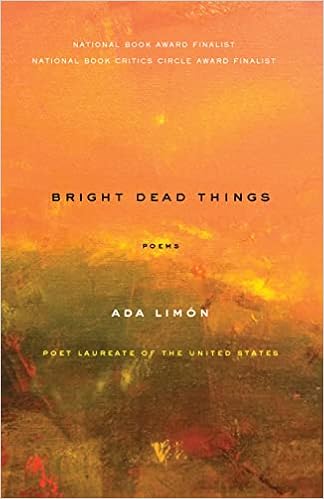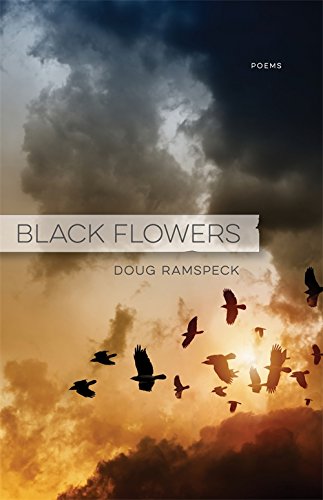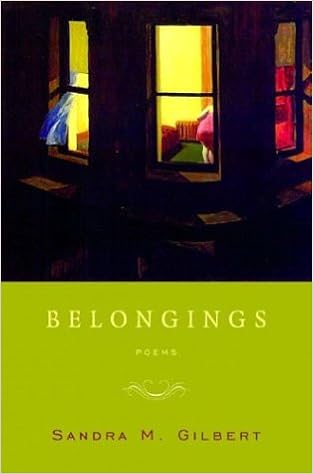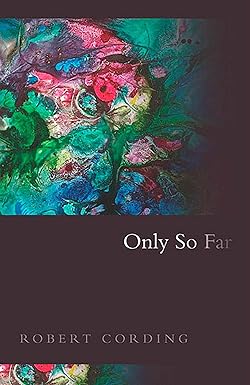Ada Limón: Bright Dead Things
We have a new national poet laureate: Ada Limón. I was familiar with the name, but could not recall reading any poems—at least nothing that stuck with me. So I grabbed a copy of Bright Dead Things. It’s not her most recent collection, but it was well received (finalist for both the National Book Award and the National Book Critics Circle Award). And though she apparently does not live in California anymore, she spent her formative years here, and I’m always happy to promote our local talent.
The poems are all free verse, with considerable variation in terms of line length, lineation, and stanzas. Skinny poems appear opposite prose poems. The language is simple and unadorned—as though you were sitting down with a good friend for a cup of coffee on a lazy afternoon. That’s not to say that Limón is deaf to the sensuality of language. Many poems display a subtle gift for alliteration and echolalia, with lines like “I’m cold in my heart, coal-hard,” “Witness the wet dead snake,” or “A bat cracks in the flickering background.” But in general, the diction is distinctly unpoetic, as evidenced by these first lines, selected mostly at random: “Six horses died in a tractor-trailer fire,” “I lied about the whales,” “Last night we killed a possum,” and “My ex got hit by a bus.”
 Landscape and locale often figure prominently, though Limón is by no means a Nature poet. Rather, what comes across is a sense of place, of belonging or of longing to belong. In “The Last Move,” she laments about “how south we were, far away in the outskirts,” further noting, “This is Kentucky, not New York, and I am not important.” This general theme, of location and dislocation, is most prominent in the first section of the book, though it also informs the remaining sections.
Landscape and locale often figure prominently, though Limón is by no means a Nature poet. Rather, what comes across is a sense of place, of belonging or of longing to belong. In “The Last Move,” she laments about “how south we were, far away in the outskirts,” further noting, “This is Kentucky, not New York, and I am not important.” This general theme, of location and dislocation, is most prominent in the first section of the book, though it also informs the remaining sections.
If Limón has a spirit animal, it must be the horse. Growing up near Sonoma, she would’ve encountered lots of them. She finds them, too, near her new home in Kentucky, though there they are not the farm workhorses or riding breeds but rather racing thoroughbreds. Are they symbolic in some way? I think it’s more accurate to say that they represent something in the liminal space between wild and domestic, which would certainly appeal to a poet with a somewhat rural upbringing. They further convey a sense of joy and exuberance at simply being alive and fully inhabiting your own body. My favorite poem in the collection, “The Wild Divine,” starts in the rush and fumble of teenage lust, in the “luck of a first love and a first full-fledged fuck,” and shifts to focus on “a wandering / madrone-skinned horse from the neighbor’s garden.” The energy of the first part of the poem, packed with description and very little punctuation, is essentially tamed in the second part, where that “wise, hoofed, grizzled, equine elder” lumbers in with a saddlebag of commas. In this way, the form echoes the brief passion and lazy afterglow that is presented in the narrative. Note, too, that wonderful adjective, “madrone-skinned,” which carries extra nuance, coming from a poet of Mexican heritage.
Still, it might be obvious by now that I am not entirely enamored of this book. While I find much to admire, it checks off too many items on my list of poetic turn-offs. For example, the use of “so” as an adverb: “so many people,” “I made the house so clean,” “It’s so small,” “so many different ways.” You can’t get much more lazy as a poet. In a genre built upon the notion that every word is essential, it’s inexcusable to use filler words. No serious poet would use the word “very”; the word “so” falls in the same category.
Many poems address an unnamed “you.” For example, “I think of you, home / with the dog,” or “your mother said she wasn’t sure / if one of your ancestors died in childbirth.” “You stopped at a friend’s / body shop to talk about a buddy.” ”You’ve gone to get us gas-station coffee.” “I decide, / someday, to name a kid Levon, and you / agree.” Every time I encounter this construction, I think, “Sorry, I think you’re confusing me with somebody else. We’ve never actually met.” A poem can be a love letter to life, but it should not be a letter to your lover.
Similarly, Limón often makes reference to people that the reader can’t be expected to know: “He’s betting / in the living room, / which T calls / the drinks room.” “It’s been exactly two months since / C died.” “I think of that walk in the Valley where J said, You don’t believe in God?” “I ran into T, and we decided we needed / to drink.” Is this a poem, or a redacted FBI dossier?
I’m also no fan of parentheses in poems: “(All the new bugs.)” “thinking this pain will / go on forever (even though it won’t).” “The mistake // I made was getting out of the car / (you told me not to).” “They gave her a goat to take to the outhouse // (not for protection but for offering).” “We both know they crack, / (Don’t we?)” A phrase or concept is either needed or it’s not; there’s no reason to be coy.
Then of course there’s the easy reliance on non sequitur. I understand this is popular nowadays, and one could argue it’s a reflection of the era, in which linear thinking seems reactionary and reality itself seems disjointed. But to me it just feels timid—a way to avoid contemplating difficult ideas or engaging the reader. It essentially says, “I probably can’t hold your attention with my line of thought, so I’ll try to hold it by confusing you.” Take these first lines from “Home Fires,” for example:
I fold the aqua blanket twice to stay alive.
Headstones in the heart’s holler, sludge
of what’s left after the mountain’s blasted.
Not a kid anymore, there are no pretty victims
or greasy cavernous villains spitting blazes.
Six lines in, and I defy anyone to explain what this poem is about.
The conversational tone is ultimately a problem for me, too. Frank O’Hara made it work most of the time, but I can’t think of many other poets who could. Art should rise above the commonplace, the ordinary, and make use of those techniques the are unique to the genre. I’m not saying all poetry should invoke “high diction,” but if it sounds like that woman at the next table talking on the phone, it just makes me want to sit somewhere else.








